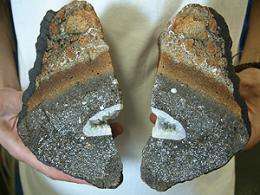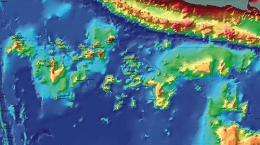Indian Ocean cocktail party leaves trail of party hats behind

(PhysOrg.com) -- Scientists have unexpectedly found traces of the supercontinent Gondwana in the Indian Ocean - in the process solving a mystery behind a large group of ocean 'mountains' known as seamounts, including Christmas Island.
The German-Australian team of marine geologists set out on the German research vessel Sonne to map and sample about 60 seamounts - ranging in height from one to three kilometers - in one the world's largest volcanic seamount provinces off the north-west Australian coast.
"These particular seamounts lie in a 200 kilometre-thick band almost parallel to the equator," said Dietmar Müller, a professor of geophysics from the University of Sydney and senior member of the team, which has just published its findings in the latest issue of Nature Geoscience.
"In contrast to other seamount zones, such as Hawaii or the Canary Islands, their existence was something of a mystery because there was no known hotspot nearby. The seamounts' ages also didn't show a progression in any particular direction - something we'd normally expect to see in volcanoes formed over hotspots."

When the researchers dated and analysed rocks from the seamounts they were surprised to find their composition must have had some influence from continental rocks. "Finding residue continental rock all the way out into the Indian Ocean was completely unexpected," Professor Müller said.
"It turns out that when continents break up they don't just split nicely down the middle and merrily go their separate ways," explained Ana Gibbons, a PhD student at the University of Sydney and one of the co-authors of the Nature Geoscience paper.
"When Gondwana was splitting apart millions of years ago, small fragments of deep, gooey continental rocks managed to get separated, lost, buried and then drawn out underneath the Indian Ocean while India and Australia drifted apart.
"Since these continental leftovers were incubated in the depths of the earth's crust for about 200 million years, they were still quite warm and buoyant. They gradually floated up when their thick continental blankets were replaced with the Indian Ocean's younger and thinner crust."
These bits of continental rock, with their varied chemical and structural make-up, were then free to mix with the young oceanic crust, Gibbons explains. "It was like a big seafloor cocktail party which left behind the party hats - or seamounts - which we can see today."
Gibbons calls this exotic alliance of oceanic and continental ingredients a "Lava Flow Cocktail" - an Indian Ocean version of the popular Hawaiian cocktail famous for its contrasting colors, flavours and temperatures.
Provided by University of Sydney



















